Plant Biology: EXAM 3, Tom Holder
hormones
-chemical messengers that regulate plant growth.
-most are transported in phloem tissues and ALL require an expenditure of energy on part of plant (ATP) for transport.
-they interact with external environmental factors to determine growth: soil moisture and temp. day length
hormones control
growth
seed germination
flowering
fruiting/seed production
shedding of leaves
color change of leaves
interact with environmental factors
1/96
There's no tags or description
Looks like no tags are added yet.
Name | Mastery | Learn | Test | Matching | Spaced |
|---|
No study sessions yet.
97 Terms
hormones
-chemical messengers that regulate plant growth.
-most are transported in phloem tissues and ALL require an expenditure of energy on part of plant (ATP) for transport.
-they interact with external environmental factors to determine growth: soil moisture and temp. day length
hormones control
growth
seed germination
flowering
fruiting/seed production
shedding of leaves
color change of leaves
interact with environmental factors
color change of leaves is due to
the breakdown of photosynthetic pigments
hormones 2 broad characteristics
growth inhibiting:
mostly fall/winter.
certain times of the year, growth is NOT good.
growth promoting:
mostly spring/summer.
Auxins
1st group of plant hormones described
growth promoting hormone
Auxins are produced in:
shoot tips
seeds
fruits
leaves
stems
NOT:
roots
Auxin Promotes
cell elongation
shoot elongation
production of wood
fruit development
Auxin Inhibits
lateral bud development
its produce new later shoots
abscission(dropping) of leaves, flowers, fruits
Cytokinins
originally detected in coconut milk
growth promoting hormone
Cytokinins produced in
seeds
fruits
roots
Cytokinins promotes
cell division
lateral bud movement (opposite of auxin)
cytokinins inhibits
leaf senescence
change of color due to breakdown of pigments (especially chlorophylls)
Gibberellins (gibberellic acids)
biggest group
growth promoting hormone
found throughout plant, but concentrated in seeds*
Gibberellins promotes
stem elongation by stimulating cell division(cytokinin) and elongation(auxin)
*breakdown of food reserves in germinating seeds.
converting starch into glucose to be respired by cells to generate ATP for speed in growth.
Gibberellins embryo
intake of water (adequate soil moisture) causes swelling and embryo hydration.
embryo secretes gibberellins.
gibberellins transported to cells of aleurone layer to secrete enzyme (alpha-amylase) for breakdown of endosperm (starchy stored food) to glucose.
embryo will respire glucose to produce ATP.
*embryo is the advantage of seed plants.
*embryo is directing the timing of germination.
Abscisic Acid inhibits
cell elongation
alpha-amylase production
trying to curb early germination
Abscisic Acid promotes
leaf senescence(loss of pigments).
production of storage carbs in seeds.
keeps endosperm from breaking down.
Ethylene
growth inhibiting hormone
actually chemical not hormone
actually is a GAS produced by incomplete metabolism
not transported in phloem
Ethylene promotes
fruit ripening
ex: bananas
abscission of leaves, fruits, flowers.
interacts with 3 growth promoting hormones to determine cell.
promotes size and shape
cells can elongate too fast b/c of weak cell walls
Seed germination
requires of dormancy—combination of internal and external factors
Seed germination: internal factors
hormones
stored food
H2O absorption
embryo swelling
seed germination: external factors
sunlight
temperature
air and soil
longer day length
longer day: higher temps
soil moisture
Generalize seed
seed coat(s), embryo, stored food
as seed coats crack:
radicle grows first down
shoot grows 2nd up
Seedling
result of cellular respiration and increase in cell size
apical meristems
internal development:
cells-tissues-organs-organism-plant
Plant Nutritional Requirements
-nutrients
-photosynthesis
-deficiency symptoms
nutrient
any substance metabolized by or incorporated into an organism
Photosynthesis requires
co2
water
elements
potassium
nitrogen
calcium
all but co2 are taken up from soil (h2o and elements)
deficiency symptoms
develop in plants that receive too little of a nutrient
Nutritional Resources
essential elements
macronutrients
micronutrients or trace elements
limiting factors
essential elements
play many roles in plant metabolism, often functioning as enzyme cofactors
macronutrients
required in amounts of at least 1g/kg of plant dry mass
-amount >
micronutrients or trace elements
-required in amounts at or less than 0.1g/kg of plant dry mass
amount -<
limiting factors
resources that can limit growth
light: photosynthesis
co2: photosynthesis
water: photosynthesis, all elongation, other factors
other mineral nutrients
overview of essential elements
16 essential elements: C, H, O from co2 (air) and h2o (water)
13 soil nutrients(minerals)
absorbed and dissolved in H2O through roots from soil
these 13 follow the same pathway through plant as h2o (xylem tissue)
Soil macronutrients
6
nitrogen (N)
potassium (K)
phosphorus (P)
Calcium (Ca)
Magnesium (Mg)
Sulfur (S)
Nitrogen (N)
component of proteins, nucleic acids, chlorophyll
potassium (K)
involved with osmosis and ion balance, opening/closing of leaf stomata (gas exchange)
phosphorus (P)
component of nucleic acids, ATP, phospholipids of plasma membrane(gatekeeper)
Calcium (Ca)
component of cell wall(support)
Magnesium (Mg)
component of chlorophyll and enzyme activator
Sulfur (S)
important for protein synthesis and enzyme function
Soil Micronutrients
7
Molybdenum (Mo)
Copper (Cu)
Zinc (Zn)
Manganese(Mn)
Chlorine(Cl)
Boron(B)
Iron(Fe)
Molybdenum (Mo)
enzyme cofactor
Copper (Cu)
enzyme cofactor
Zinc (Zn)
enzyme cofactor
Manganese (Mn)
enzyme cofactor
involved with chloroplast
membrane and for oxygen release with photosynthesis
Chlorine (Cl)
splitting of H2O in photosynthesis (generates electron energy)
ion balance
Boron (B)
enzyme cofactor
cell wall component
nucleic acid synthesis
Iron (Fe)
enzyme cofacto
component of cytochromes
photosynthesis and cellular respiration
necessary for synthesis of chlorophyll
Overview of Flowering Plant Reproduction
most flowering plants display sexual reproduction
2 gametes fuse to produce offspring with unique combinations of genes
they also undergo Alteration of Generations
What is Alteration of Generations?
2 multicellular life cycle stages
diploid and haploid
Diploid
spore-producing sporophyte
produces spores by meiosis
2N to 1N
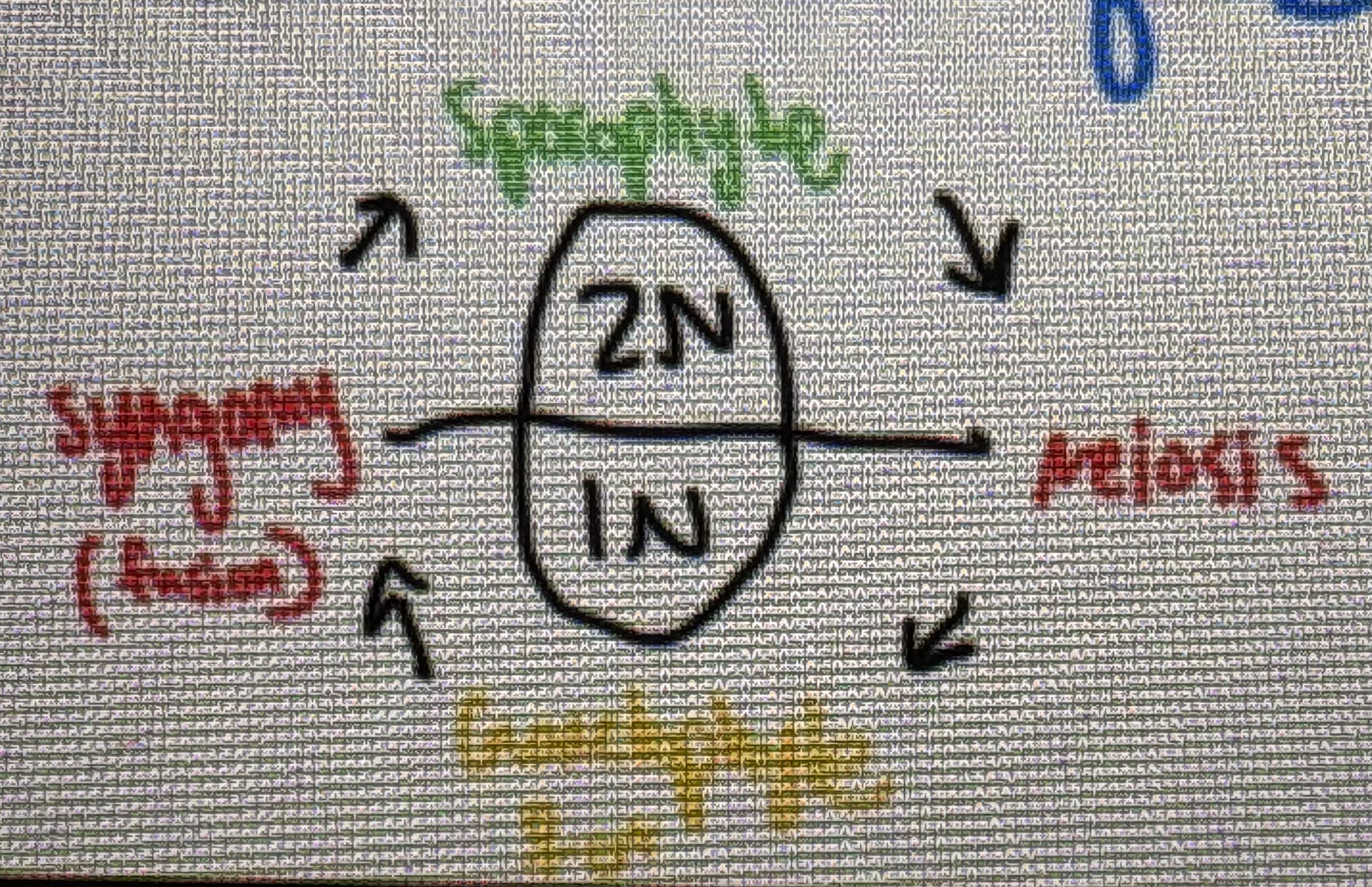
Haploid
gamete-producing gametophyte
produces spores by mitosis
1N to 1N
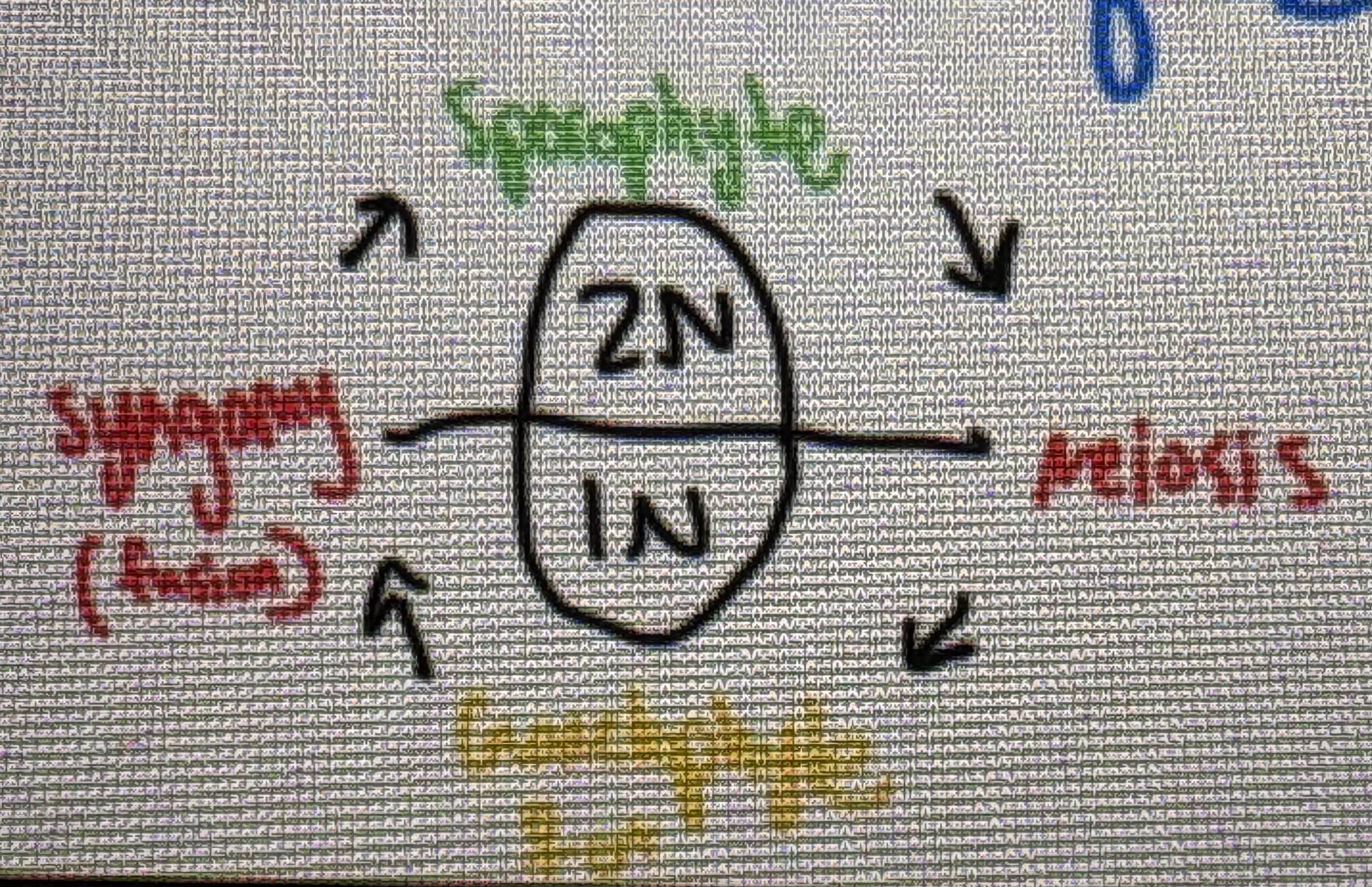
Evolutionary Trends of Sporophyte and Gametophyte
S:
has become larger and more complex
G:
has become smaller and less complex
Evolutionary Trends of Moss
Sporophytes small and dependent on gametophyte
Evolutionary Trends of a Flowering Plant
Sporophyte is larger and independent. Also is more complex than gametophytes
Dependent gametophytes are few-celled and contained within flowers
Flower and Sexual Cycle
Flowers: ONLY in angiosperms; all sizes, shapes, colors, aromas
essential processes of sexual reproduction occur within the flower
What are the essential processes of sexual reproduction that occur within a flower?
meiosis/cytokinesis
reduces chromosome number
2N to 1N
syngamy
fertilization
restores chromosome number
1N egg + 1N sperm = 2N zygote (fertilized egg)
“Ideal” Flower
4 sets of highly modified leaves arranged in whorls at the tip of a highly modified stem.
A flower is a highly modified determinate (short term) shoot system
shoot includes: stem and leaves
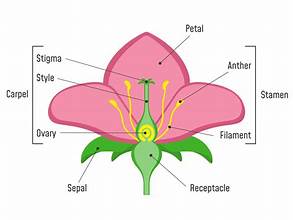
Part of the Flower and their functions:
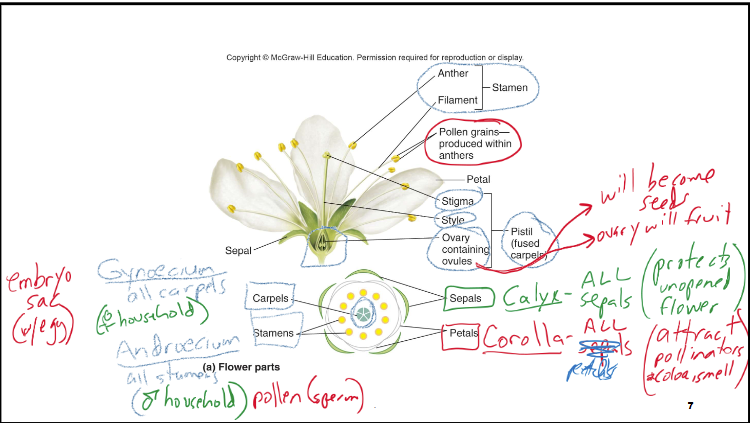
Flower Diagram: important ideas
Pedicel
flower stalk
Receptacle
enlarged tip of pedicel
4 sets of highly modified leaves
ALL are 2N and attached to receptacle and part of the sporophyte generation
Pollen (sperm) and egg (within embryo sec) are part of the 1N gametophyte generation
Sexual Cycle: MALE side occur site
Pollen formation:
occurs within the anther of stamen.
2N microspore mother cells
micro: male side/very small

Anther
bilobed with 2 pollen chambers per lobe
Sexual Cycle: MALE pollination
pollination
transfer of pollen from anther to a stigma of pistil
self-pollination and cross-pollination
self-pollination
transfer with same flower or between flowers on same plant.
decreases genetic generation
not the best :(
cross-pollination
transfer between flowers of different plants
increases genetic variation
good! :)
Sexual Cycle: Pollinating Agents
pollinating agents:
mechanisms utilized for transfer of pollen
3 types: wind, water, animals
Pollinating Agent: Wind
small, light weight pollen
Pollinating Agent: Water
transfer with a few aquatic plants
Pollinating Agent: Animals
MAJORITY of plants utilize a ‘trick and reward’ system
trick and reward:
nectar, colors, aromas to attract animals
Sexual Cycle: FEMALE: Ovule Development
female side:
ovule: future seed
enclosed within ovary of pistil(carpel)
one to many ovules per ovary
ovary: future fruit
ovule attached to central axis or to wall of a hollow ovary—ALWAYS enclosed(angiospermy)
Angiospermy
ALWAYS enclosed hollow ovary
within ovule is 1 large 2N cell is called?
megaspore mother cell
mega: female, large
Sexual Cycle: FEMALE: ovary with enclosed ovules
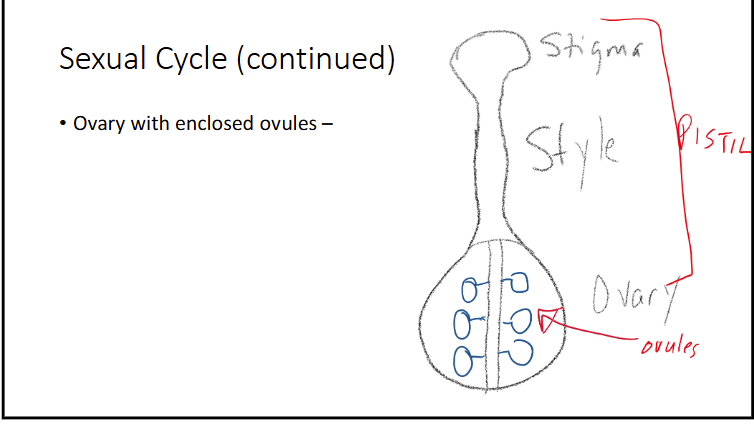
Sexual Cycle: FEMALE: ovule enlarged
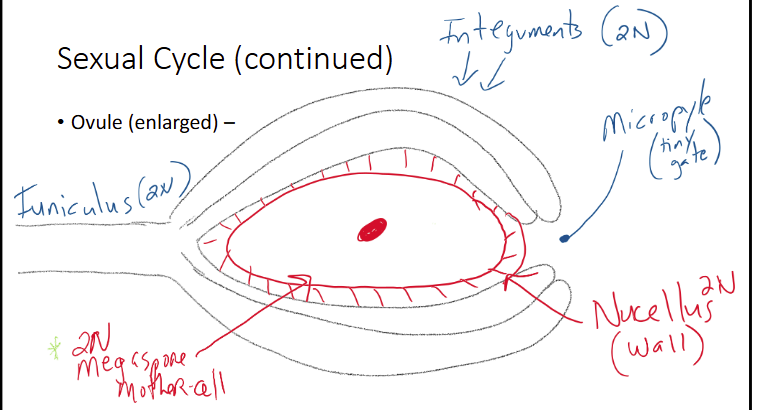
Sexual Cycle: FEMALE: megaspore transformation

Sexual Cycle: FEMALE: megaspore to embryo sac process
1N functional megaspore to start
3 mitosis/cytokinesis divisions
unequal and incomplete
one cell with 1N nucleus become 8 (1N) nuclei, but only 7 cells
Embryo sac created
making a female gametophyte
inside
Sexual Cycle: FEMALE: embryo structure
Embryo sac
8 nucleate, 7-celled structure=female gametophyte
3 antipodal cells (1N) → opposite end from micropyle
1 central cell with 2 large 1N nuclei (polar nuclei)
2 synergid cells (1N) → micropyle end on outside
1 egg (1N) → middle at micropyle end
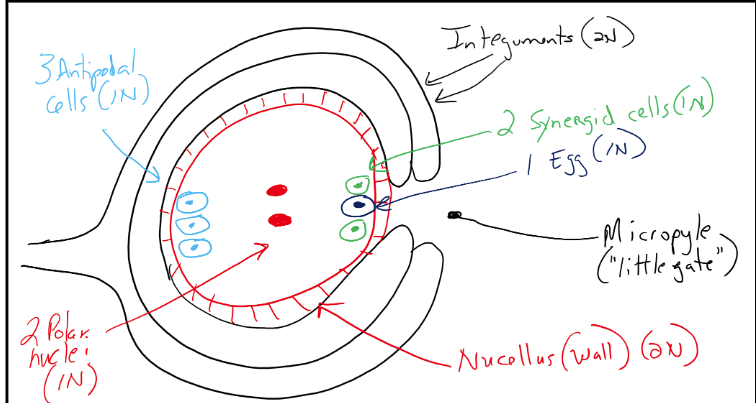
Sexual Cycle: FEMALE: syngamy
Syngamy:
1N egg + 1N sperm = 2N zygote (single cell, fertilized egg)
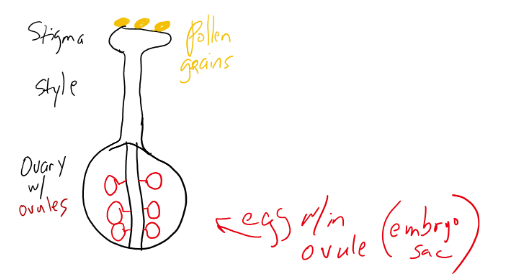
Pollen Grain Germination
tube cell forms pollen tube.
generative cell divides by mitosis/cytokinesis to produce 2 sperm

Sexual Cycle: FEMALE: pollen tube process
pollen tube enters micropyle of ovule; digest nucellus.
pollen tube delivers perm to location of the egg.
pollen tube enter one synergid then releases its contents and synergid ruptures.
tube nucleus degrades and 2 sperms release into large central cell
micropyle closes up
Sexual Cycle: FEMALE: double fertilization
“fusion”
both sperms fuse with other nuclei
1N egg + 1N sperm = 2N zygote (fertilized egg)
1N sperm + 2N polar nuclei = 3N primary endosperm cell
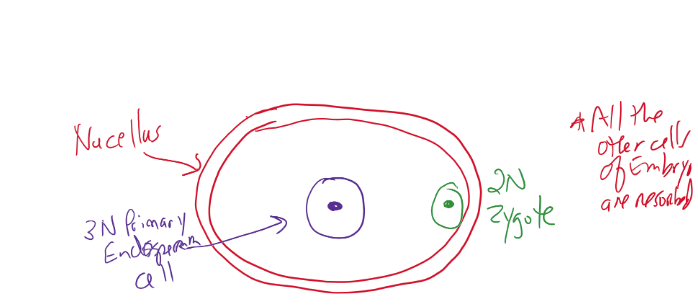
Sexual Cycle: FEMALE: post fertilization
within ovule
2N zygote grows by mitosis/cytokinesis into 2N multicellular embryo
3M primary endosperm grows by mitosis/cytokinesis into 3N multicellular endosperm(nutritive tissue for embryo)
inside the ovule
2N integuments HARDEN to form SEED COATS! *
Sexual Cycle: FEMALE: ending, seed dispersal, agents
Ovule with 2N zygote mature into seed with 2N multicellular embryo and ovary enlarges with sugars/H2O into a fruit(mature ovary) with enclosed seeds(mature ovules).
seed dispersal
seeds enclosed within fruit
has pollinating agents
wind
water
animals (MAJORITY)
Sexual Cycle: FEMALE: seed germination
seed with 2N embryo enter period of dormancy
dormancy broken by a combination of internal and external(environmental) factors
radical (1st root) emerges and grows down
shoot (2nd) emerges and grows up
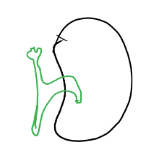
Plant Genetics
the study of genes, genetic variation, and heredity specifically in plants.
Plant Genetics: DNA
deoxyribonucleic acid
the building block of life
made up of individual nucleotides
4 potential nitrogenous bases
DNA’s 4 potential nitrogenous bases
Adenine (A)
Thymine (T)
Cytosine (C)
Guanine (G)
A and T
C and G
Plant Genetics: DNA: how traits are coded
genotype:
genetic information of certain traits
sequence of the nucleotide bases
phenotype:
physical expression of that trait
ex: tall or short
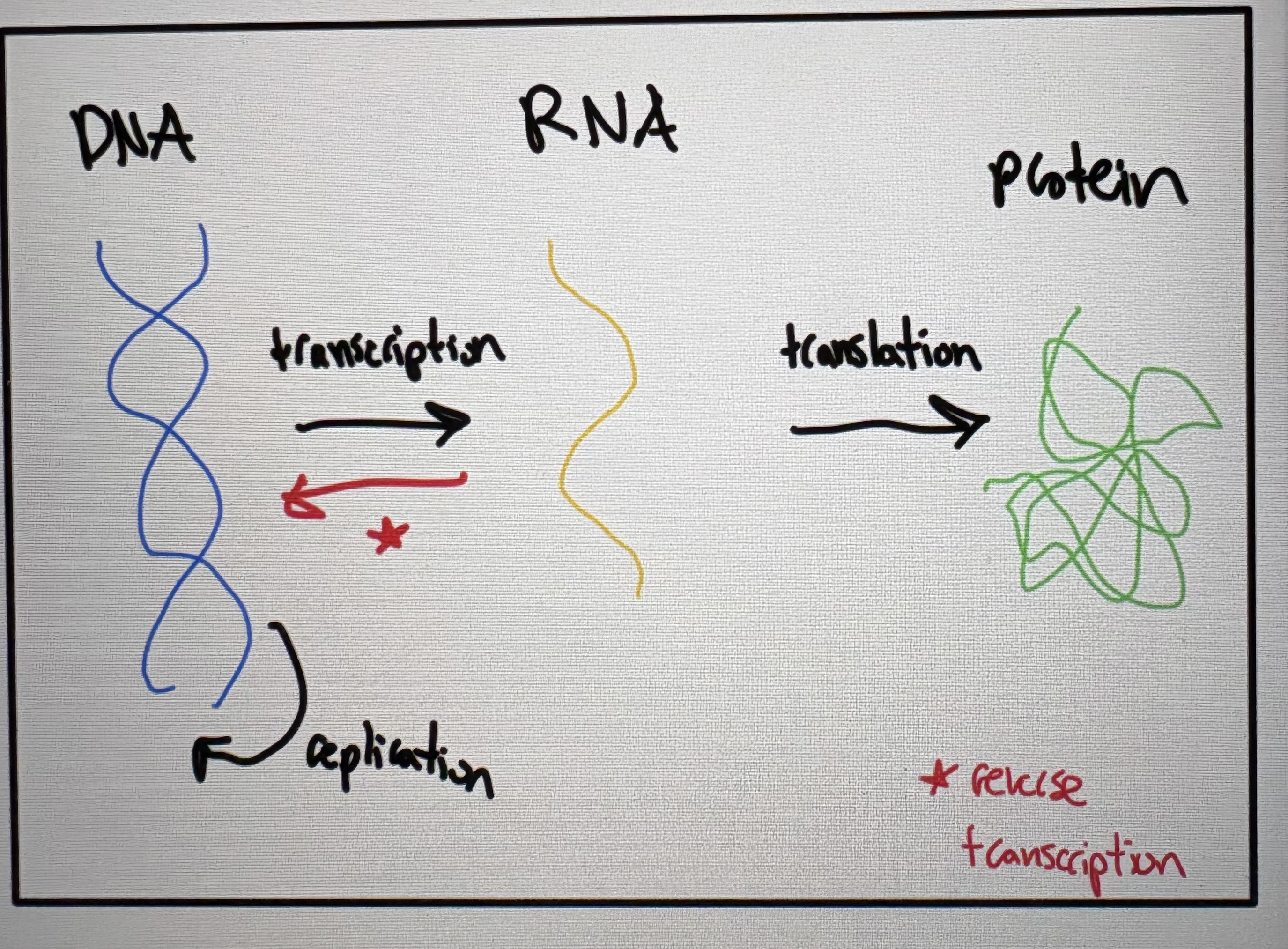
Plant Genetics: Monohybrid Cross
2 parents with different genes/traits
dominant and recessive
homozygous and heterozygous
Dominant trait
visible trait
uppercase
Recessive trait
marked trait
lowercase
Homozygous
2 copies of same allele
ex: AA or aa
Homo dominant
AA
Homo recessive
aa
Heterozygous
2 different alleles
ex: Aa
Punnet Squares
parent 1 on y-axis
parent 2 on x-axis
used to determine genotype ratio, phenotype ratio, and percentage of genotype and phenotype.
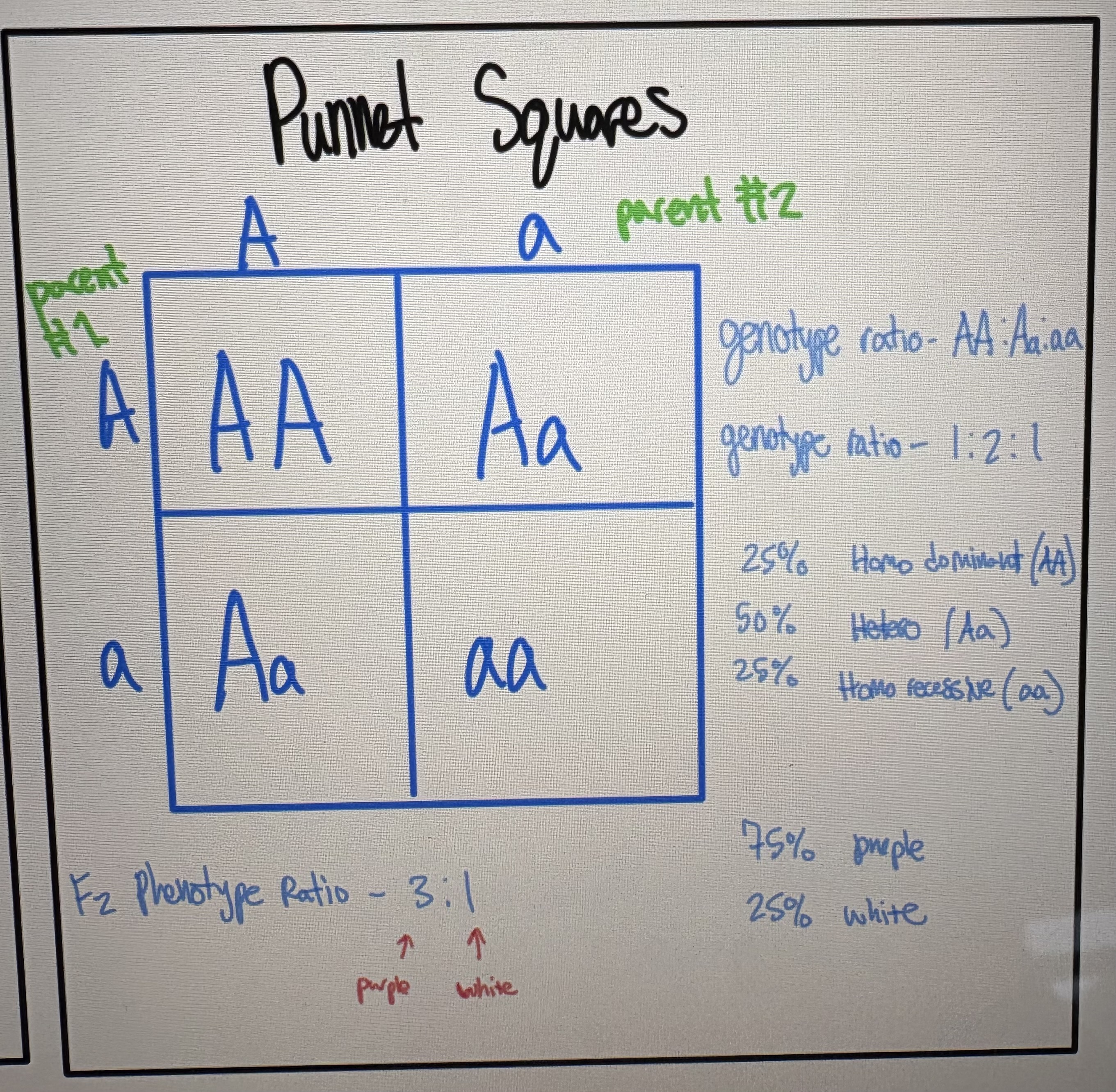
Mutations
change in order or structure of genetic information (DNA)
most are neutral, don’t affect
some can be lethal/harmful and some can be beneficial
ex:
white/albino squirrels
rare recessive mutation
no pigment in fur
red eyes
Mutations provide what?
genetic variation
change in one base substitution can create 2 completely different proteins
ex:
ATCGTTCG: protein 1
AGCGTTCG: protein 2
sunlight goes onto T in protein 1 altering it and then altering/changing the base substitution and creating a different protein.